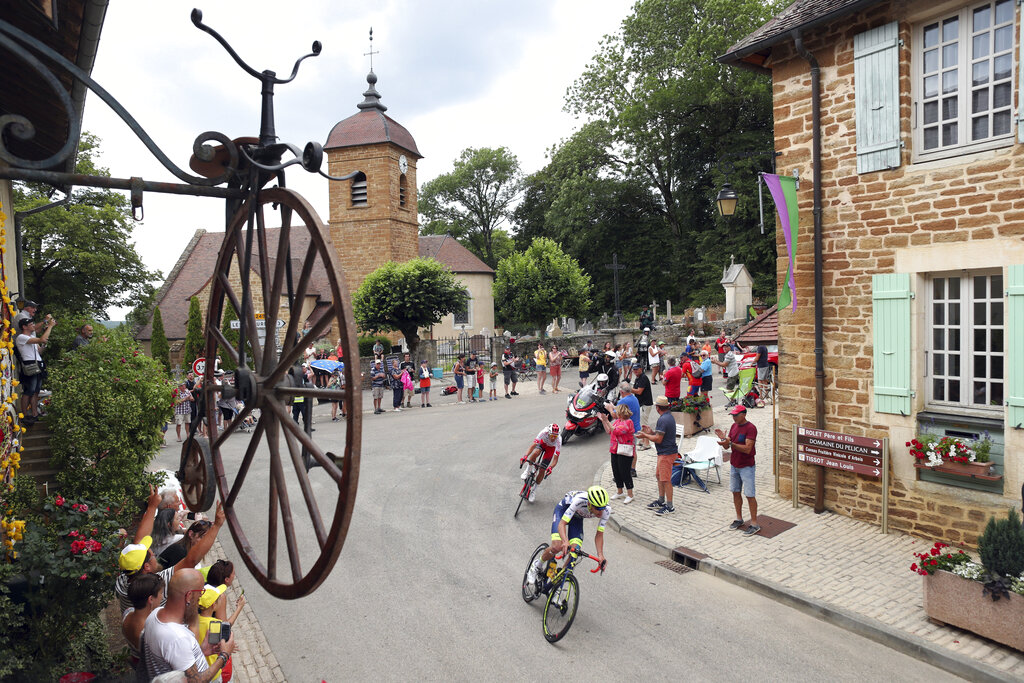Taste of the Tour: Salty riders in the town of ‘white gold’

France’s Yoann Offredo, center, and France’s Stephane Rossetto, ride breakeway during the seventh stage of the Tour de France cycling race over 230 kilometers (142,9 miles) with start in Belfort and finish in Chalon sur Saone, France, Friday, July 12, 2019. (AP Photo/Thibault Camus)
CHALON-SUR-SAONE, France — At the Tour de France, it’s time to talk about salt.
Through their sweat, Tour riders lose several grams of salt a day, often visible as white stains on their shorts and jerseys after long, hot rides like the 230 kilometers (143 miles) they covered on Friday on Stage 7, the longest this month. Dylan Groenewegen clocked an astounding 74 kph (46 mph) in a finishing sprint that won the Dutch rider the stage; Giulio Ciccone kept the yellow jersey.
As it happens, the hilly and then largely flat route from Belfort, a town of 50,000 people in eastern France where fried carp is a specialty, to the more central riverside town of Chalon-sur-Saone saw the 174 riders zoom through a town built on the production of “white gold,” or salt.
The Great Saltworks of Salins-les-Bains, listed as a world heritage site by the United Nations’ cultural organization UNESCO, pumped naturally salted brine from deep underground to make salt. The brine was cooked in vast metal vats, heated underneath with wood fires and, from the 19th century, with coal, to boil off the water, leaving the crystalized salt. Bare-chested workers scooped out the salt with shovels for drying and bagging. The work was backbreaking, the heat infernal.
After 1,200 years of production, the no-longer profitable saltworks closed in 1962. The site is now an engrossing museum. Visitors are led underground to the pump room where brine is still drawn from the earth when needed in winter to de-ice the town’s roads. Foolhardy visitors are also invited to taste the brine, direct from a tap. It’s foul, far saltier than seawater.
Tour riders get their salts from tastier sports drinks they gulp in the saddle. Support riders, devoted to their team leaders who are chasing the overall Tour title or victories in the 21 stages to the finish in Paris on July 28, regularly drop back to team cars to pick up bottles, prepared that morning with powders and electrolyte tablets.
Fans clamor for riders to toss them their empties at the finish, and scramble for the souvenirs. But woe to riders who toss empties into the countryside, outside of designated zones. Defending champion Geraint Thomas was fined the equivalent of $203 for carelessly discarding a bottle — called bidons in cycling — on Stage 6.
If his riders on the Bora Hansgrohe team need extra salt on top of what they’re already getting in their drinks, nutritionist Robert Gorgos suggests salting their evening soups. Salt improves their intake of water, which they sweat by the bucket-load as they race.
“For the athletes it’s important to have enough,” Gorgos says.
French chefs would agree. The best do far more with salt than just sprinkle it in their dishes; they bake in it, too. Try doing it with raw beets, a whole head of celeriac or a big fish. Take a couple of kilos (several pounds) of coarse sea salt, jazz it up with chopped herbs, maybe also some Sichuan pepper and lemon zest, bury the vegetables or fish in the middle and bake, not too hot. The vegetables can survive several hours in the oven like this, and will emerge tender and sweet. Slice, butter and eat.
BREAD AND BUTTER: The stage win for Groenewegen, who rides with “Dylan” written large on his race helmet, helped make up for the disappointment of crashing on Stage 1, where he hit the deck hard and sat slumped on the tarmac, oozing unhappiness. The Dutch sprinter on Friday edged Australian rival Caleb Ewan and former world champion Peter Sagan of Slovakia to claim his fourth career stage win of the Tour.
QUOTE OF THE DAY: “Everything was starting to ache by the end, your wrists and your feet and stuff” — Thomas, the defending champion, describing the stage.
STAT OF THE DAY: 3. The numbers of riders on the daily medical bulletin listing those treated by Tour doctors during the stage. Mike Teunissen and Tejay van Garderen got attention after crashing; Luis Leon Sanchez was treated for an insect bite.
NEXT ON THE MENU: Stage 8 from the wine town of Macon to the former coal-mining center of Saint-Etienne is as lumpy as a bad béchamel sauce, with seven hill climbs of note. The pack may let a group of low-placed riders ride off ahead for the stage win.